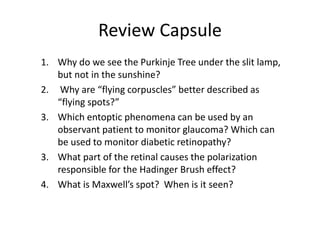

Historically,therewerefewteststoassessvisioninULVpatients.Inthe1990s,thefield of visual prosthetics expanded rapidly, and this activity led to a heightened need to develop better tests to quantify end points for clinical studies. The technical challenges faced by eachofthesedisciplinesdifferconsiderably,buttheyallfacethesamechallengeofhow toassessvisioninpatientswithultra-lowvision(ULV),whowillbetheearliestsubjects toreceivenewtherapies. Translational research in vision prosthetics, gene therapy, optogenetics, stem cell and other forms of transplantation, and sensory substitution is creating new therapeutic options for patients with neural forms of blindness. Finally, the visual prosthesis is proposed as a model for a general high-fidelity machine-brain interface. The theory of operation of visual prostheses is discussed, along with a review of the current state of knowledge. Of particular interest to the neurosurgical community is placement of deep brain stimulating electrodes in thalamic structures that has shown substantial promise in an animal model. In this article the authors review the potential locations for stimulation electrode placement for visual prostheses, assessing the anatomical and functional advantages and disadvantages of each. It is thus widely thought that a device-based prosthetic approach to restoration of visual function will be effective and will enjoy similar success as cochlear implants have for restoration of auditory function.

The visual pathway, however, as a predominantly central structure, is largely spared in these cases. This article reviews the possibility of an ancient forgotten language of visual signs and symbols, which is genetically existent in the human brain and emerges during ASCs, trance states, and consciousness altered by psychoactive plants.Ĭommon causes of blindness are diseases that affect the ocular structures, such as glaucoma, retinitis pigmentosa, and macular degeneration, rendering the eyes no longer sensitive to light. Long before the creation of languages, visual perception and information were the only source for mankind, alone of the primates, to perceive the outer world. Also entoptic images exist in many folkloric, traditional and cultural geometrical shapes. Entopic images and phosphenes have been found in various cultural works of art and in the drawings on cave walls, which were formed during shamanic religious rituals since Neolithic times. Some of these simple geometric forms are called entoptic images and phosphenes. An important property of these natural chemicals is to induce the human psyche to perceive optical forms and shapes that are existent in the subconscious and presumed collective unconsciousness, and which emerge during certain trance states and ASCs (altered states of consciousness). Some of the psychoactive plants used for religious purposes were: narcotic analgesics (opium), THC (cannabis), psilocybin (magic mushrooms), mescaline (peyote), ibogaine (Tabernanthe iboga), DMT (Ayahuasca and Phalaris species), Peganum harmala, bufotenin, muscimol (Amanita muscaria), Thujone (absinthe, Arthemisia absinthium), ephedra, mandragora, star lotus, Salvia divinorum etc. Although this suggests the photobiophysical source of negative afterimages is related retinal mechanisms, cortical neurons have also essential contribution in the interpretation and modulation of negative afterimages.ĪBSTRACT Psychoactive plants have been consumed by many cultures, cults and groups during religious rituals and ceremonies for centuries and they have been influential on the eruption of many images, secret and religious symbols, esoteric geometrical shapes, archetypes, religious figures, and philosophy of religions since the dawn of Homo sapiens. Finally, these reemitted photons can be absorbed by non-bleached photoreceptors that produce a negative afterimage. In other words, when we stare at a colored (or white) image for few seconds, external photons can induce excited electronic states within different parts of the eye that is followed by a delayed reemission of absorbed photons for several seconds. Here, we suggest that the photobiophysical source of negative afterimage can also occur within the eye by delayed bioluminescent photons.

Recently, Wang, Bókkon, Dai and Antal (2011) presented the first experimental proof of the existence of spontaneous ultraweak biophoton emission and visible light induced delayed ultraweak photon emission from in vitro freshly isolated rat's whole eye, lens, vitreous humor and retina. The delayed luminescence of biological tissues is an ultraweak reemission of absorbed photons after exposure to external monochromatic or white light illumination.


 0 kommentar(er)
0 kommentar(er)
